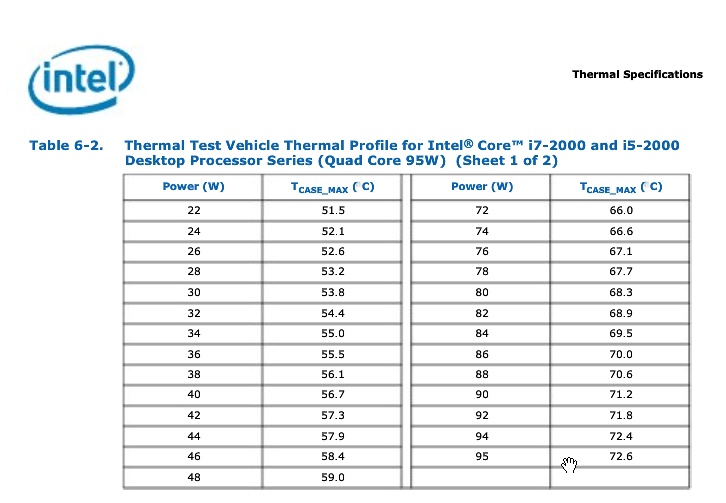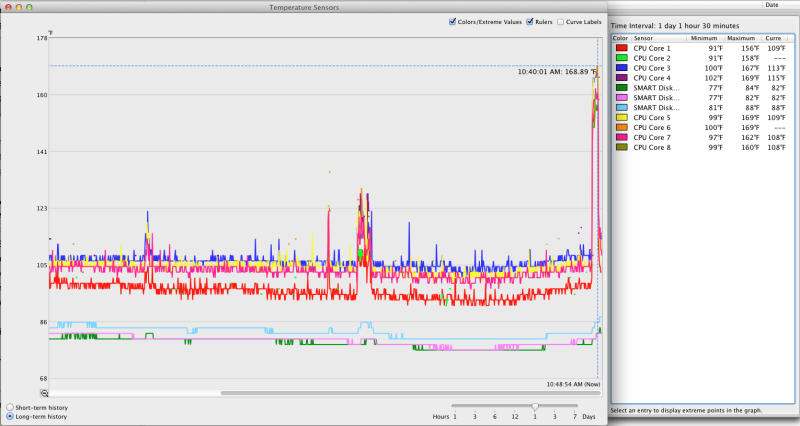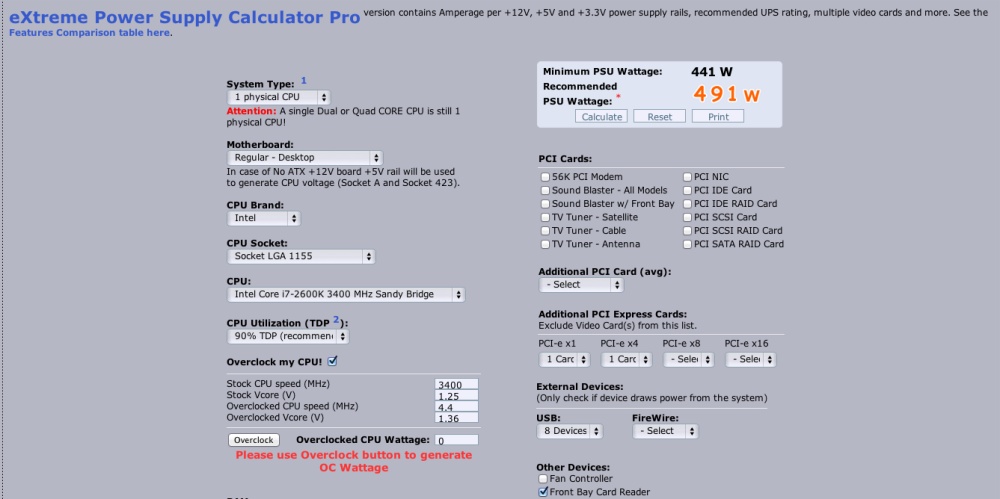The optimum setting.
Computer builder FU Steve writes about overclocking, heat management and power supply selection:
Having had a few days to experiment with the Core i7-2600 Intel CPU in the HP100, replacing the excellent i5, I set about varying overclock settings to see where the sweet point lies for Thomas’s HP100 Hackintosh.
The willingness of these CPUs to be overclocked falls, like most populations, on a Bell curve. Most will go to some decent OC, some will not, some will be superstars.
From much of what I have read the stock 3.4GHz speed is easily increased to 4.4GHz (+29%) simply by changing one setting in BIOS, the frequency multiplier. Thereafter things get tricky.
Here are my findings with settings for a stable running CPU; Geekbench results are shown also:

Intel Core i7-2600K overclocking table.
As is clear, the law of diminishing returns kicks in rapidly beyond 4.4GHz with Thomas’s sample of the i7. Go from 4.4 to 4.5GHz, a barely noticeable 3% Geekbench increase, and the idle temperature rises 8F. Go to 4.6GHz, a further 3% Geekbench improvement, and the temperature jumps another 11F, or 19F warmer than at 4.4GHz. After that the temperature rise:speed trade-off worsens quickly. You have to start juicing the core voltages significantly, Bclck is maxed out at 1005, and heat skyrockets. This is not consonant with a long, hard-working life for the CPU which, at $280, is the costliest part in the computer case.
Vcore will be set by the BIOS to 1.36 volts if you leave that setting (in “Advanced Frequency Settings”) at ‘Auto’. However, for maximum stability, override the Auto setting and set it to 1.385 volts. The maximum permitted by Intel is 1.50 volts, so it’s not like you are over-stressing anything.
Optimal setting? 4.4gHz, Vcore 1.385 volts, all other variables at default, failsafe BIOS settings, aftermarket CPU cooler.
In high stress scenarios, such as ripping and compressing a movie file, you can add 70F to the core temperature, so at 4.4GHz the temperature rises to 169F. Intel publishes exhaustive technical data on its CPUs, and you can find the following table in its 2nd Gen Intel® Core™ Processor, LGA1155 Socket: Thermal Guide which makes for fascinating reading:

Thermal table for the 2nd generation Intel i5 and i7 Sandy Bridge CPUs.
The maximum power consumption of the desktop Core i7 is 95W, at which point Intel specifies a case temperature of 72.6C (162.7F). Case temperature (the outside of the CPU) is 22F lower than CPU core temperature (the inside), which is where the temperature sensors used by apps like Bresink’s Temperature Monitor (free download) reside. So Intel’s maximum of 162.7F becomes 184.7F as a safe limit temperature as reported by Temperature Monitor.
In the following 24 hour chart I show temperature for all the cores. The small spikes half way across are for Carbon Copy Cloner running overnight SSD and HDD back-up jobs at 2am and 3am. The peak here is 129F – no biggie. The massive spike at the end is where I used HandBrake to rip a 4gB DVD movie and compress the result to H264 format for playing on an AppleTV2. The process took all of 11 minutes, by the way, and as you can see from the data, all eight cores of the i7 were working hard. There were several LR4 and PS CS5 sessions in the 24 hour period illustrated, but they barely register any heat increase. This is a mighty testimony to the suitability of the HP100 for still picture processing.

24 hrs, concluding with a movie rip/compress.
Ambient temperature was 75F when ripping the movie. The Core temperature rises to 169F, 15.7F below the Intel recommended core maximum of 184.7F. That’s slim headroom, but very safe, owing to the variable speed fan fitted to the large Coolermaster 212 CPU cooler – all of $28 and the best money you can spend on your Hack. Ripping movies with the ineffectual stock Intel cooler is a bad idea. For that matter, ripping movies on any iMac or, worse, MacBook Pro or MacMini, where cooling is severely compromised in the interest of sexy looks on the sales floor, is a positively rotten idea. Hey, it’s your money but be warned. Other than the MacPro, Apple’s hardware is simply unsuited to prolonged movie processing.
Here then is how my Hackintosh HP100 is set with regard to CPU speed and cooling. I use an Antec Sonata III case with the stock 500 watt power supply and two 120mm case fans – these can be manually switched to H/M/L.
- Rear case exhaust fan – L.
- HDD case fan – M.
- CPU 120mm fan – variable – attached to Coolermaster 212 CPU radiator. This fan spools up instantly when the CPU heats up.
- Intel Core i7-2600K CPU – overclocked to 4.4GHz.
- BIOS CPU warning set at 176F – this will flash the temperature display from Temperature Monitor in the menu bar.
If overclocking you should experiment with frequency multipliers. Assuming you are using an efficient aftermarket CPU cooler, start by taking the stock frequency multiplier setting of 34x to 38x for the i7, the maximum supported by Intel’s warranty. Then take it up in steps of 2x, doing a Geekbench and Cinebench GPU run each time. The former will report CPU speed, the latter measures GPU speed and is also a good stability test. Once you get a Kernel Panic (grey screen with warnings) in OS X you know you have reached the simple adjustment limit and need to revert to the last stable setting, and you are done.
A note on ambient temperature. My measurements disclose that a 2F rise in room temperature results in a 1F rise in idle CPU core temperature. The above movie rip/compress was at an ambient temperature of 75F. At 95F ambient (we get that a few days a year in the Bay Area, and have no air conditioning) that means the CPU will be 10F warmer, meaning a peak temperature of 179F when ripping/compressing a movie, still within the 184.7F safe limit.
Preliminary measurements on the new MacBook Pro with Retina Display disclose that this is an exceptionally hot running machine, probably owing to the over-spec’d display, something no one needs in a small 15″ screen. And it doesn’t even have a DVD drive. I dread to think what its temperature runs once you connect an external DVD burner for ripping movies.
Determining power supply needs:
It’s easy to overlook the need to correctly specify the power supply when building a high performance Hackintosh. There’s an excellent free calculator at Outervision Extreme where you simply input your components to determine the wattage needed. Not all watts are the same. A cheap PSU with light windings and chintzy transformer iron cores will overheat and compound heat management and stability issues. Good brands include Antec and Thermaltake. I have used both extensively with no issues and many builders to whom I have recommended these remain happy. Here’s my output after using that calculator:

The result suggests that HP100 is bumping up against its limits with its 500 watt PSU, and that a beefier power supply may be called for in the interests of cool running and stability. Mercifully, the upgrade involves a few screws and a couple of connectors, and less than $100. There is no beating stock PC parts for price and reliability.
Thank you, FU, for that timely update, coming on the heels of your sterling work (FU is English, after all!) on the recent HP100 CPU upgrade.